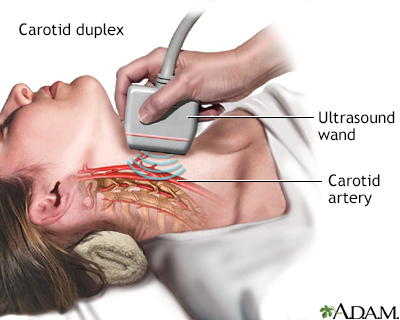Strokes are one of the leading causes of death and long-term disability worldwide. While they often strike without warning, the good news is that many strokes are preventable with early detection and lifestyle changes. One of the most effective ways to detect stroke risk is through a carotid artery scan. These scans can identify blockages or narrowing in the carotid arteries before symptoms appear, helping people take preventive action before a medical emergency occurs.
In this blog, we will explore what a carotid artery scan is, why it is so important for stroke prevention, who should consider getting one, and what to expect during the process. We will also discuss the benefits of early detection, clarify some common myths. You will also get a closer look at what happens when a technician is preparing a patient for a cranial CT scan and why this matters for your overall health.
What Is a Carotid Artery Scan?
A carotid artery scan is a diagnostic test that checks for blockages or narrowing in the carotid arteries, which are located on both sides of your neck. These arteries are responsible for carrying oxygen-rich blood from your heart to your brain. When they become narrowed due to plaque buildup, it significantly increases the risk of a stroke.
There are several types of carotid artery scans:
- Carotid ultrasound: A non-invasive test that uses sound waves to create images of the arteries and measure blood flow.
- CT angiography (CTA): Combines a CT scan with a contrast dye to show detailed images of blood vessels.
- MRI angiography (MRA): Uses magnetic fields and radio waves to visualize blood vessels without radiation exposure.
Each method is designed to evaluate the structure and function of the arteries, helping doctors identify any areas of concern.
Why Are Carotid Artery Scans Important for Stroke Prevention?
Strokes often occur when the blood flow to the brain is interrupted, usually because of a blockage caused by a blood clot or a buildup of fatty deposits. The carotid arteries are a common location for these blockages. When plaque narrows these arteries, it limits the flow of blood to the brain, which can result in a stroke.
Carotid artery scans are essential for early detection. They help doctors find problems before symptoms arise. Early intervention can include medication, lifestyle changes, or even surgical procedures like carotid endarterectomy or stenting. These treatments can reduce the risk of a full-blown stroke.
Who Should Get a Carotid Artery Scan?
While not everyone needs this test, certain groups of people are at higher risk of developing carotid artery disease and should consider getting screened.
People who should consider a carotid scan include:
- Individuals aged 55 and older
- Those with high blood pressure or diabetes
- Smokers or former smokers
- People with high cholesterol
- Individuals with a family history of stroke or heart disease
- Those who live a sedentary lifestyle
- People who have already experienced a transient ischemic attack (TIA), also known as a mini stroke
If your doctor hears an unusual sound in your neck, called a bruit, during a routine exam, they may also recommend a carotid scan. This sound can be a sign of turbulent blood flow due to narrowing of the artery.
Read more: Can You Reverse Androgenetic Alopecia? What Science Says
What to Expect During the Scan
Many people feel nervous about medical tests, but a carotid scan is simple and painless.
If you are having a carotid ultrasound, you will lie on an exam table while a technician applies a special gel to your neck. Then they will move a handheld device called a transducer over your skin. This device uses sound waves to create images of your arteries and measure how well blood is flowing.
In the case of a CT or MRI angiography, you may be asked to lie still in a scanning machine. A contrast dye might be injected into your arm to help highlight the blood vessels. These scans may take a bit longer, but they provide more detailed images and are still non-invasive.
It is worth noting that when a technician is preparing a patient scan, their role is crucial. They ensure you are positioned correctly, explain the procedure, and help you remain calm throughout the process. This careful preparation is part of what makes these scans so reliable and safe.
How Accurate Are Carotid Artery Scans?
Carotid artery scans are very accurate, especially when performed by experienced technicians using modern equipment. Carotid ultrasound, for example, can detect even small amounts of plaque buildup or narrowing. CT and MRI scans provide additional detail and are often used when more information is needed to plan treatment.
Doctors use the results of these scans, combined with other health information, to determine the best course of action. The reliability of these tests makes them an excellent choice for assessing stroke risk and planning preventive care.
Benefits of Early Detection Through Carotid Imaging
The earlier a problem is identified, the better the chances of preventing serious complications. Here are some key benefits of early detection through carotid artery scans:
- Lower risk of stroke: Early treatment can prevent blockages from causing a stroke.
- Customized care: Doctors can create a personalized plan that may include medication, diet changes, or surgery.
- Peace of mind: Knowing your artery health status can help reduce anxiety and improve your quality of life.
- Cost savings: Preventing a stroke is far less expensive than treating one, especially when it leads to long-term disability.
- Better overall health: Identifying artery issues can also reveal risks in other areas, prompting broader lifestyle improvements.
Taking action now can lead to a healthier future and reduce the risk of a sudden, life-changing event.
Common Myths About Stroke Risk and Carotid Scans
Many people avoid getting screened because of common misunderstandings. Let’s clear up a few myths.
- Myth 1: “I don’t have symptoms, so I don’t need a scan.”
Truth: Carotid artery disease often has no symptoms until a stroke occurs. Screening can catch it early.
- Myth 2: “Only older people get strokes.”
Truth: Strokes can affect younger adults too, especially if they have risk factors like smoking or high blood pressure.
- Myth 3: “If something was wrong, my doctor would have noticed.”
Truth: Doctors rely on both physical exams and screening tools. A bruit may not always be present, so a scan offers more clarity.
Understanding the facts can help you take control of your health with confidence.
Where to Get a Carotid Artery Scan
If you think you may be at risk, the first step is to talk to your primary care physician. They can evaluate your health history and refer you for a scan if necessary.
Carotid artery scans are available at most hospitals, diagnostic imaging centers, and specialty clinics. When looking for a provider, choose one with certified technicians and a strong reputation for accurate, timely results. Most health insurance plans cover the cost of a scan when it is medically necessary, so be sure to check your coverage.
Conclusion:
Carotid artery scans play a vital role in preventing strokes by identifying blockages or narrowing in the arteries before symptoms appear. Furthermore, these scans are safe, accurate, and accessible, making them an essential tool in proactive healthcare. If you have risk factors such as high blood pressure, diabetes, a history of smoking, or a family history of stroke, it is important to speak with your doctor about getting screened.
Additionally, early detection allows for timely treatment, whether that means lifestyle changes, medications, or procedures to restore healthy blood flow. By understanding your risk and acting early, you can greatly reduce the chances of suffering a life-altering stroke. Don’t wait for symptoms to appear. Talk to your healthcare provider or find a trusted diagnostic imaging center near you and take a powerful step toward protecting your brain and your future.












